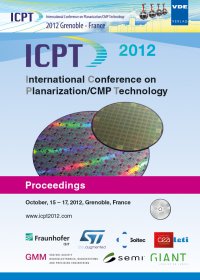A Study on the Damaged Layer Characteristic of Wafer by using Chemical-Mechanical Polishing
Conference: ICPT 2012 - International Conference on Planarization / CMP Technology
10/15/2012 - 10/17/2012 at Grenoble, France
Proceedings: ICPT 2012
Pages: 6Language: englishTyp: PDF
Personal VDE Members are entitled to a 10% discount on this title
Authors:
Park, Chuljin; Lee, Sangjik; Kim, Doyeon; Lee, Taekyung; Kim, Hyoungjae (Korea Institute of Industrial Technology, Jisa-Dong, Gangseo-Gu, Busan, 618-230, South Korea)
Jeon, Minhyon (School of Nano Engineering, 607, Inje University, Obang-Dong, Gimhae, gyeongnam, 621-749, South Korea)
Abstract:
Diamond-Mechanical Polishing (DMP) and Chemical-Mechanical Polishing (CMP) process determine the final quality of wafers in the sapphire wafering process for LED applications. DMP process improves flatness of wafer by controlling total thickness variation (TTV) and CMP process removes damaged layer that is generated during DMP process and reduces surface roughness. The important factor in DMP process is to reduce depth of damaged layer to decrease total polishing time in CMP process. In this paper, damaged layer is evaluated by analyzing removal rate, evolution of surface roughness and the correlation between these two factors by using CMP process. Also evaluation method to characterize damaged layer is studied by using chemical etching of polished wafer. Keywords: damaged layer, surface roughness, etching, sapphire, Chemical-Mechanical Polishing (CMP), Diamond-Mechanical Polishing (DMP).


